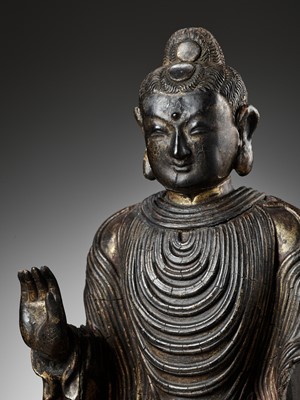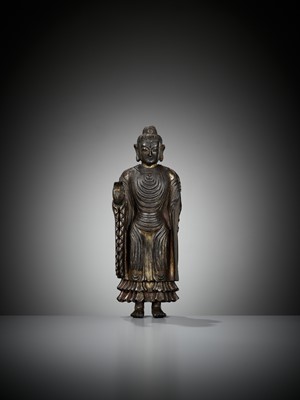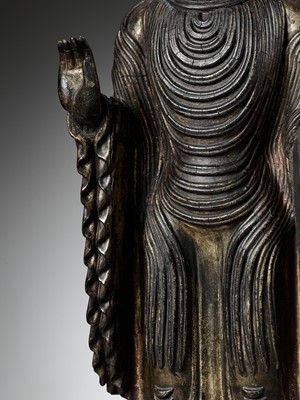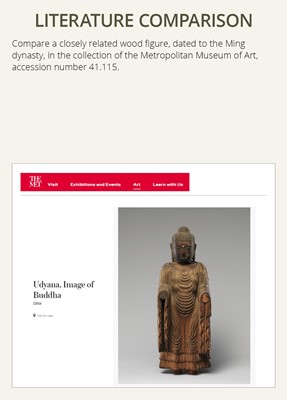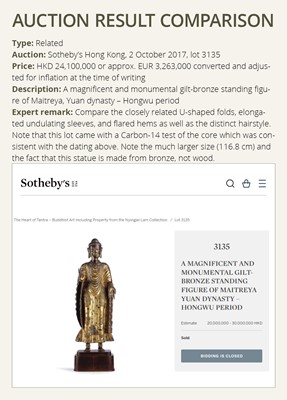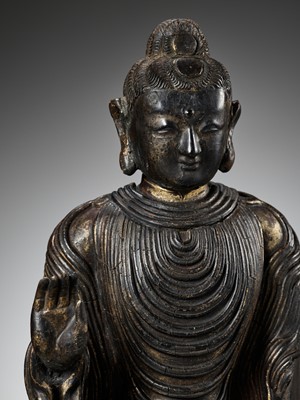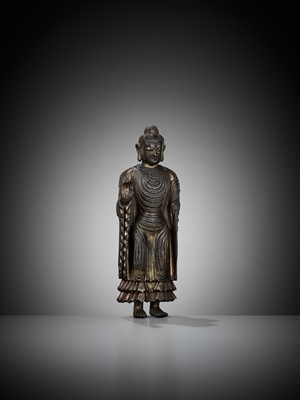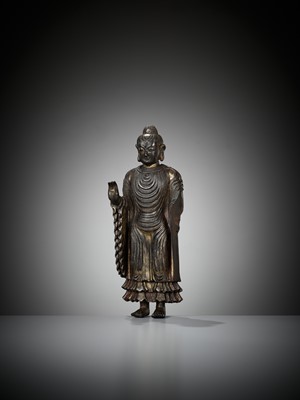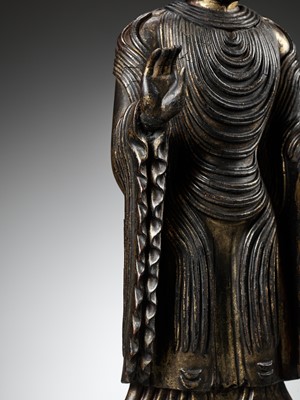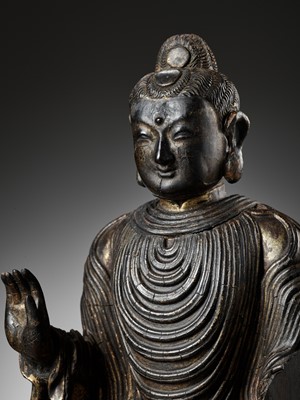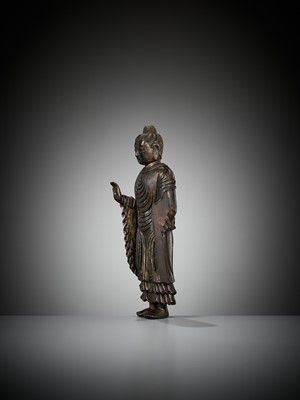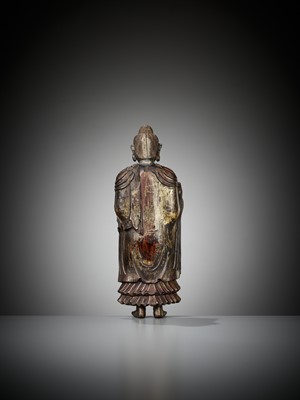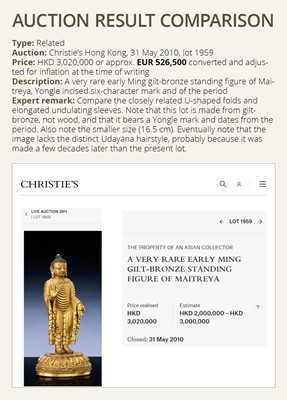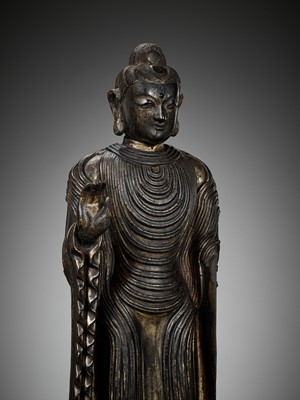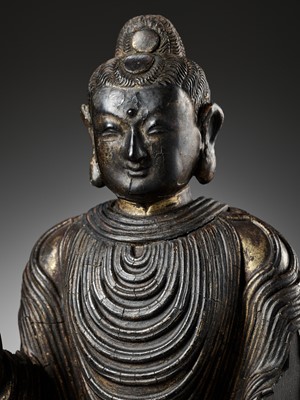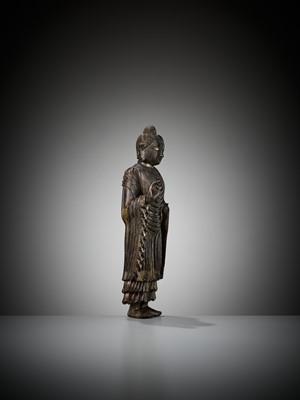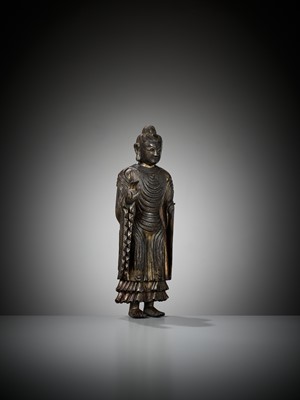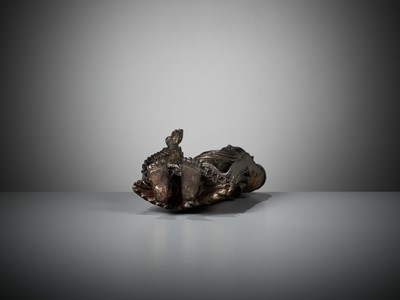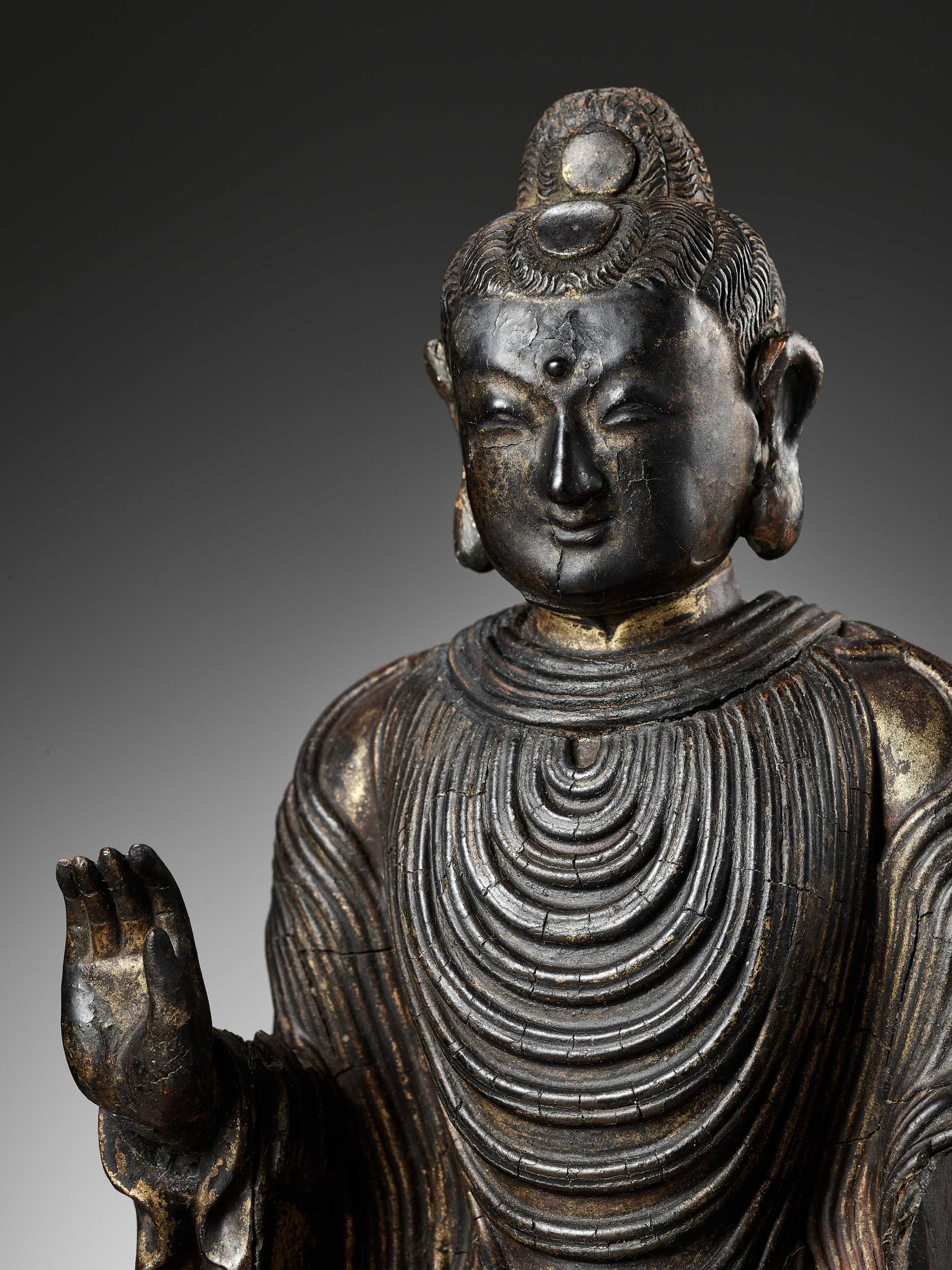29th Sep, 2022 13:00
DAY 1 - TWO-DAY AUCTION - Fine Chinese Art / 中國藝術集珍 / Buddhism & Hinduism
164
AN IMPORTANT AND RARE UDAYANA-STYLE FIGURE OF MAITREYA, LATE YUAN DYNASTY - HONGWU PERIOD
元末至洪武朝重要烏仗那式彌勒佛木雕像
Sold for €10,400
including Buyer's Premium
Opinion: The present statue is stylistically very similar to an important gilt-bronze figure of Maitreya, which can be pinpointed by radiocarbon dating of organic material in its core to a quite narrow timeframe from the late Yuan dynasty to the Hongwu period. The distinct U-shaped folds, elongated undulating sleeves, and flared hems, as well as the characteristic hairstyle, all indicate that the two figures were made at more or less exactly the same time, around the years 1350-1380.
The image is superbly carved standing with his right hand raised in abhaya mudra, the deity portrayed with a serene and meditative countenance below an urna, framed by a pair of long pendulous earlobes and hair neatly swept over the ushnisha, clad in a long robe with elongated sleeve openings and accentuated overall with pronounced folds and undulations, the garment loosely clinging to the gently rounded outlines of his stomach and legs and ending in a flaring hem above the bare feet.
Provenance: A Belgian private collection.
Condition: Good condition, commensurate with age and presenting remarkably well, especially when considering the high age of this statue. Extensive wear and expected natural age cracks. Minor flaking and crackling to lacquer. Light surface scratches, minuscule nicks, some losses. Possibly few minor old touchups here and there.
Weight: 787.9 g
Dimensions: Height 31.2 cm
Maitreya, Buddha of the Future Age, governs two perfected worlds: Tusita Heaven, which he currently inhabits, and Ketumati, an ideal realm conducive to the pursuit of enlightenment where he will serve as the teaching Buddha. The Maitreya's hands are held in abhaya and varada mudras, embodying a message of the coming salvation of all sentient beings.
As the Yuan dynasty crumbled amidst famine, floods and general unrest, the anti-Mongol slogan of Han Shantong, Grand Patriarch of the White Lotus sect, was a call to arms and rebellion. Central to Han’s belief structure was the idea that Buddha Maitreya had finally manifested in the world as the successor to Buddha Shakyamuni. Shortly after Han’s demise in 1351, Zhu Yuanzhang, also a member of the White Lotus sect, emerged as the leader of the ethnic Han Chinese rebelling against the Mongol-led Yuan dynasty. In 1368, he eventually proclaimed himself as the Hongwu Emperor of the newly established Ming dynasty. It was during this period that images of Buddha Maitreya, such as the present lot, were depicted almost exclusively in the distinct Udayana style which gained increased popularity.
The formulaic rendering of the U-shaped folds of the robe is one of the most interesting iconographic features of the present figure. This is known as Udayana, an ancient name for the early Gandharan region now in the present-day Swat Valley, Pakistan, from which similarly robed images of Maitreya first originated. This distinctive style of dress had transmitted along the Silk Road all the way to China and appeared there as early as the fourth century, as exemplified by the gilt-bronze seated Buddha Shakyamuni illustrated by H. Munsterberg, in Chinese Buddhist Bronzes, New York, 1988, page 37, fig. 1, which bears an inscription dated to 338 AD.
Literature comparison:
Compare a closely related wood figure, dated to the Ming dynasty, in the collection of the Metropolitan Museum of Art, accession number 41.115.
Auction result comparison:
Type: Related
Auction: Sotheby’s Hong Kong, 2 October 2017, lot 3135
Price: HKD 24,100,000 or approx. EUR 3,263,000 converted and adjusted for inflation at the time of writing
Description: A magnificent and monumental gilt-bronze standing figure of Maitreya, Yuan dynasty – Hongwu period
Expert remark: Compare the closely related U-shaped folds, elongated undulating sleeves, and flared hems as well as the distinct hairstyle. Note that this lot came with a Carbon-14 test of the core which was consistent with the dating above. Note the much larger size (116.8 cm) and the fact that this statue is made from bronze, not wood.
Auction result comparison:
Type: Related
Auction: Christie’s Hong Kong, 31 May 2010, lot 1959
Price: HKD 3,020,000 or approx. EUR 526,500 converted and adjusted for inflation at the time of writing
Description: A very rare early Ming gilt-bronze standing figure of Maitreya, Yongle incised six-character mark and of the period
Expert remark: Compare the closely related U-shaped folds and elongated undulating sleeves. Note that this lot is made from gilt-bronze, not wood, and that it bears a Yongle mark and dates from the period. Also note the smaller size (16.5 cm). Eventually note that the image lacks the distinct Udayana hairstyle, probably because it was made a few decades later than the present lot.
元末至洪武朝重要烏仗那式彌勒佛木雕像
造像身軀豐滿,姿態高貴,右手施無畏印,佛面微笑頭髮整齊地披在烏尼沙上,佛像通肩式之外袍,自肩膀垂直而下,佛像身形高挑,裙褶疊曲有序,氣韻生動,神彩宛如書法揮毫。
專家意見:這尊佛像在風格上與一尊重要的鎏金彌勒佛銅像非常相似,通過對其核心的有機材料進行放射性碳鑑定,可能為元代後期至洪武時期。明顯的U型褶皺、拉長的起伏袖子、外翻的下擺以及特有的髮型,都表明這兩尊佛像或多或少是在同一時期大約在1350-1380年製作的。
來源:比利時私人收藏。
品相:品相良好,保存狀況符合其年代。大面積的磨損、可預期的自然老化裂縫。漆面有輕微剝落和裂紋。表面輕微劃痕、少量刻痕,左手缺損。局部可能有舊修復。
重量:787.9 克
尺寸:高31.2 厘米
彌勒佛是釋迦牟尼佛的繼任者,將在未來娑婆世界降生成佛,將從兜率天降到人間,他右手掌上舉,左手朝下,意謂阿彌陀佛自淨土下生,救助眾生,接引極樂世界。
當元朝在饑荒、洪水的動亂時期,白蓮教大教主韓山童號召武裝勢力反蒙古。韓山童自稱為彌勒佛下凡救世。1351年韓山童去世後不久,白蓮教成員之一的朱元璋,成為反抗蒙古人的漢族領袖。1368年,朱元璋建立明朝,即為明太祖或洪武皇帝。正是在這一時期,關於彌勒佛的作品,如本拍品,幾乎完全都是獨特的烏仗那式風格,並越來越受歡迎。
衣褶如波浪流動。其風格特徵,早見於四世紀末、五世紀初,被稱為烏仗那式。烏仗那乃古巴基斯坦,斯瓦特穀一帶舊名,屬早期犍陀羅,風格源自高古犍陀羅造像與早期中亞文化,反映出古典希臘化藝術與古印度的深遠影響。如H. Munsterberg在《中國佛教青銅器》(紐約,1988年,第 37 頁,圖 1)中所展現的鎏金青銅釋迦牟尼坐佛就是例證,上面刻有公元 338 年的銘文。
文獻比較:
比較一件非常相近的明代烏仗那式佛陀木雕像,收藏於大都會藝術博物館,編號41.115。
拍賣結果比較:
形制:相近
拍賣:香港蘇富比,2017年10月2日,lot 3135
價格:HKD 24,100,000(相當於今日EUR 3,263,000)
描述:元至明洪武鎏金銅彌勒佛立像
專家評論:比較非常相近的衣褶如波浪流動、拉長的波浪形袖子,喇叭狀的下擺以及獨特的髮型。請注意此立像經碳十四測驗,結果與斷代相吻合。請注意尺寸較大 (116.8 厘米) ,此像是青銅製而非木雕。
拍賣結果比較:
形制:相近
拍賣:香港佳士得,2010年5月31日,lot 1959
價格:HKD 3,020,000(相當於今日EUR 526,500)
描述:明永樂鎏金銅彌勒佛立像 《大明永樂年施》刻款
專家評論:比較非常相近的衣褶如波浪流動、拉長的波浪形袖子。請注意此像為鎏金銅像,非木雕,且為大明永樂款及年代,尺寸較小 (16.5 厘米)。請注意髮型也和現拍品不同,可能因為年代較晚。
Opinion: The present statue is stylistically very similar to an important gilt-bronze figure of Maitreya, which can be pinpointed by radiocarbon dating of organic material in its core to a quite narrow timeframe from the late Yuan dynasty to the Hongwu period. The distinct U-shaped folds, elongated undulating sleeves, and flared hems, as well as the characteristic hairstyle, all indicate that the two figures were made at more or less exactly the same time, around the years 1350-1380.
The image is superbly carved standing with his right hand raised in abhaya mudra, the deity portrayed with a serene and meditative countenance below an urna, framed by a pair of long pendulous earlobes and hair neatly swept over the ushnisha, clad in a long robe with elongated sleeve openings and accentuated overall with pronounced folds and undulations, the garment loosely clinging to the gently rounded outlines of his stomach and legs and ending in a flaring hem above the bare feet.
Provenance: A Belgian private collection.
Condition: Good condition, commensurate with age and presenting remarkably well, especially when considering the high age of this statue. Extensive wear and expected natural age cracks. Minor flaking and crackling to lacquer. Light surface scratches, minuscule nicks, some losses. Possibly few minor old touchups here and there.
Weight: 787.9 g
Dimensions: Height 31.2 cm
Maitreya, Buddha of the Future Age, governs two perfected worlds: Tusita Heaven, which he currently inhabits, and Ketumati, an ideal realm conducive to the pursuit of enlightenment where he will serve as the teaching Buddha. The Maitreya's hands are held in abhaya and varada mudras, embodying a message of the coming salvation of all sentient beings.
As the Yuan dynasty crumbled amidst famine, floods and general unrest, the anti-Mongol slogan of Han Shantong, Grand Patriarch of the White Lotus sect, was a call to arms and rebellion. Central to Han’s belief structure was the idea that Buddha Maitreya had finally manifested in the world as the successor to Buddha Shakyamuni. Shortly after Han’s demise in 1351, Zhu Yuanzhang, also a member of the White Lotus sect, emerged as the leader of the ethnic Han Chinese rebelling against the Mongol-led Yuan dynasty. In 1368, he eventually proclaimed himself as the Hongwu Emperor of the newly established Ming dynasty. It was during this period that images of Buddha Maitreya, such as the present lot, were depicted almost exclusively in the distinct Udayana style which gained increased popularity.
The formulaic rendering of the U-shaped folds of the robe is one of the most interesting iconographic features of the present figure. This is known as Udayana, an ancient name for the early Gandharan region now in the present-day Swat Valley, Pakistan, from which similarly robed images of Maitreya first originated. This distinctive style of dress had transmitted along the Silk Road all the way to China and appeared there as early as the fourth century, as exemplified by the gilt-bronze seated Buddha Shakyamuni illustrated by H. Munsterberg, in Chinese Buddhist Bronzes, New York, 1988, page 37, fig. 1, which bears an inscription dated to 338 AD.
Literature comparison:
Compare a closely related wood figure, dated to the Ming dynasty, in the collection of the Metropolitan Museum of Art, accession number 41.115.
Auction result comparison:
Type: Related
Auction: Sotheby’s Hong Kong, 2 October 2017, lot 3135
Price: HKD 24,100,000 or approx. EUR 3,263,000 converted and adjusted for inflation at the time of writing
Description: A magnificent and monumental gilt-bronze standing figure of Maitreya, Yuan dynasty – Hongwu period
Expert remark: Compare the closely related U-shaped folds, elongated undulating sleeves, and flared hems as well as the distinct hairstyle. Note that this lot came with a Carbon-14 test of the core which was consistent with the dating above. Note the much larger size (116.8 cm) and the fact that this statue is made from bronze, not wood.
Auction result comparison:
Type: Related
Auction: Christie’s Hong Kong, 31 May 2010, lot 1959
Price: HKD 3,020,000 or approx. EUR 526,500 converted and adjusted for inflation at the time of writing
Description: A very rare early Ming gilt-bronze standing figure of Maitreya, Yongle incised six-character mark and of the period
Expert remark: Compare the closely related U-shaped folds and elongated undulating sleeves. Note that this lot is made from gilt-bronze, not wood, and that it bears a Yongle mark and dates from the period. Also note the smaller size (16.5 cm). Eventually note that the image lacks the distinct Udayana hairstyle, probably because it was made a few decades later than the present lot.
元末至洪武朝重要烏仗那式彌勒佛木雕像
造像身軀豐滿,姿態高貴,右手施無畏印,佛面微笑頭髮整齊地披在烏尼沙上,佛像通肩式之外袍,自肩膀垂直而下,佛像身形高挑,裙褶疊曲有序,氣韻生動,神彩宛如書法揮毫。
專家意見:這尊佛像在風格上與一尊重要的鎏金彌勒佛銅像非常相似,通過對其核心的有機材料進行放射性碳鑑定,可能為元代後期至洪武時期。明顯的U型褶皺、拉長的起伏袖子、外翻的下擺以及特有的髮型,都表明這兩尊佛像或多或少是在同一時期大約在1350-1380年製作的。
來源:比利時私人收藏。
品相:品相良好,保存狀況符合其年代。大面積的磨損、可預期的自然老化裂縫。漆面有輕微剝落和裂紋。表面輕微劃痕、少量刻痕,左手缺損。局部可能有舊修復。
重量:787.9 克
尺寸:高31.2 厘米
彌勒佛是釋迦牟尼佛的繼任者,將在未來娑婆世界降生成佛,將從兜率天降到人間,他右手掌上舉,左手朝下,意謂阿彌陀佛自淨土下生,救助眾生,接引極樂世界。
當元朝在饑荒、洪水的動亂時期,白蓮教大教主韓山童號召武裝勢力反蒙古。韓山童自稱為彌勒佛下凡救世。1351年韓山童去世後不久,白蓮教成員之一的朱元璋,成為反抗蒙古人的漢族領袖。1368年,朱元璋建立明朝,即為明太祖或洪武皇帝。正是在這一時期,關於彌勒佛的作品,如本拍品,幾乎完全都是獨特的烏仗那式風格,並越來越受歡迎。
衣褶如波浪流動。其風格特徵,早見於四世紀末、五世紀初,被稱為烏仗那式。烏仗那乃古巴基斯坦,斯瓦特穀一帶舊名,屬早期犍陀羅,風格源自高古犍陀羅造像與早期中亞文化,反映出古典希臘化藝術與古印度的深遠影響。如H. Munsterberg在《中國佛教青銅器》(紐約,1988年,第 37 頁,圖 1)中所展現的鎏金青銅釋迦牟尼坐佛就是例證,上面刻有公元 338 年的銘文。
文獻比較:
比較一件非常相近的明代烏仗那式佛陀木雕像,收藏於大都會藝術博物館,編號41.115。
拍賣結果比較:
形制:相近
拍賣:香港蘇富比,2017年10月2日,lot 3135
價格:HKD 24,100,000(相當於今日EUR 3,263,000)
描述:元至明洪武鎏金銅彌勒佛立像
專家評論:比較非常相近的衣褶如波浪流動、拉長的波浪形袖子,喇叭狀的下擺以及獨特的髮型。請注意此立像經碳十四測驗,結果與斷代相吻合。請注意尺寸較大 (116.8 厘米) ,此像是青銅製而非木雕。
拍賣結果比較:
形制:相近
拍賣:香港佳士得,2010年5月31日,lot 1959
價格:HKD 3,020,000(相當於今日EUR 526,500)
描述:明永樂鎏金銅彌勒佛立像 《大明永樂年施》刻款
專家評論:比較非常相近的衣褶如波浪流動、拉長的波浪形袖子。請注意此像為鎏金銅像,非木雕,且為大明永樂款及年代,尺寸較小 (16.5 厘米)。請注意髮型也和現拍品不同,可能因為年代較晚。
Zacke Live Online Bidding
Our online bidding platform makes it easier than ever to bid in our auctions! When you bid through our website, you can take advantage of our premium buyer's terms without incurring any additional online bidding surcharges.
To bid live online, you'll need to create an online account. Once your account is created and your identity is verified, you can register to bid in an auction up to 12 hours before the auction begins.
Intended Spend and Bid Limits
When you register to bid in an online auction, you will need to share your intended maximum spending budget for the auction. We will then review your intended spend and set a bid limit for you. Once you have pre-registered for a live online auction, you can see your intended spend and bid limit by going to 'Account Settings' and clicking on 'Live Bidding Registrations'.
Your bid limit will be the maximum amount you can bid during the auction. Your bid limit is for the hammer price and is not affected by the buyer’s premium and VAT. For example, if you have a bid limit of €1,000 and place two winning bids for €300 and €200, then you will only be able to bid €500 for the rest of the auction. If you try to place a bid that is higher than €500, you will not be able to do so.
Online Absentee and Telephone Bids
You can now leave absentee and telephone bids on our website!
Absentee Bidding
Once you've created an account and your identity is verified, you can leave your absentee bid directly on the lot page. We will contact you when your bids have been confirmed.
Telephone Bidding
Once you've created an account and your identity is verified, you can leave telephone bids online. We will contact you when your bids have been confirmed.
Classic Absentee and Telephone Bidding Form
You can still submit absentee and telephone bids by email or fax if you prefer. Simply fill out the Absentee Bidding/Telephone bidding form and return it to us by email at office@zacke.at or by fax at +43 (1) 532 04 52 20. You can download the PDF from our Upcoming Auctions page.
How-To Guides
How to Create Your Personal Zacke Account
How to Register to Bid on Zacke Live
How to Leave Absentee Bids Online
How to Leave Telephone Bids Online
中文版本的操作指南
创建新账号
注册Zacke Live在线直播竞拍(免平台费)
缺席投标和电话投标
Third-Party Bidding
We partner with best-in-class third-party partners to make it easy for you to bid online in the channel of your choice. Please note that if you bid with one of our third-party online partners, then there will be a live bidding surcharge on top of your final purchase price. You can find all of our fees here. Here's a full list of our third-party partners:
- 51 Bid Live
- EpaiLive
- ArtFoxLive
- Invaluable
- LiveAuctioneers
- the-saleroom
- lot-tissimo
- Drouot
Please note that we place different auctions on different platforms. For example, in general, we only place Chinese art auctions on 51 Bid Live.
Bidding in Person
You must register to bid in person and will be assigned a paddle at the auction. Please contact us at office@zacke.at or +43 (1) 532 04 52 for the latest local health and safety guidelines.
